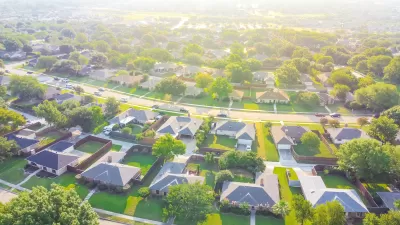What the shoe industry can teach us about the housing crisis.

In an excerpt from their upcoming book, Escaping the Housing Trap: The Strong Towns Response to the Housing Crisis, Charles Marohn and Daniel Herriges claim that “If We Made Shoes Like We Make Housing, People Would Go Barefoot.”
To illustrate their point, the authors write, “Imagine a shoe market that produces only two kinds of shoes: a high-end loafer and an elite-brand tennis shoe.” Companies and governments incentivize the production of just two types of shoe, and “Local permitting restricts the number of shoes that can be made. Rising prices have bloated supply chains, making everything more expensive. The extensive web of public and private capital vested in producing high-end loafers and elite-brand tennis shoes stifles innovation.”
In this world, “Lots of people who want shoes can’t get them. They go barefoot. Those who can buy shoes feel financially squeezed. Price increases are normalized, even expected. Many people are desperate to get any pair of shoes.”
This scenario seems unrealistic—for shoes. “Yet our present housing crisis, which seems normal to us, would be absurd to anyone living a century ago. In the context of millennia of human development, we are the first culture to find ourselves with a chronic shortage of housing.”
For the authors, the answer is clear: “We wiped out the starter rung on the ladder. We need a housing market that produces penny loafers again.”
FULL STORY: If We Made Shoes Like We Make Housing, People Would Go Barefoot

Planetizen Federal Action Tracker
A weekly monitor of how Trump’s orders and actions are impacting planners and planning in America.

San Francisco's School District Spent $105M To Build Affordable Housing for Teachers — And That's Just the Beginning
SFUSD joins a growing list of school districts using their land holdings to address housing affordability challenges faced by their own employees.

The Tiny, Adorable $7,000 Car Turning Japan Onto EVs
The single seat Mibot charges from a regular plug as quickly as an iPad, and is about half the price of an average EV.

Seattle's Plan for Adopting Driverless Cars
Equity, safety, accessibility and affordability are front of mind as the city prepares for robotaxis and other autonomous vehicles.

As Trump Phases Out FEMA, Is It Time to Flee the Floodplains?
With less federal funding available for disaster relief efforts, the need to relocate at-risk communities is more urgent than ever.

With Protected Lanes, 460% More People Commute by Bike
For those needing more ammo, more data proving what we already knew is here.
Urban Design for Planners 1: Software Tools
This six-course series explores essential urban design concepts using open source software and equips planners with the tools they need to participate fully in the urban design process.
Planning for Universal Design
Learn the tools for implementing Universal Design in planning regulations.
Smith Gee Studio
City of Charlotte
City of Camden Redevelopment Agency
City of Astoria
Transportation Research & Education Center (TREC) at Portland State University
US High Speed Rail Association
City of Camden Redevelopment Agency
Municipality of Princeton (NJ)





























